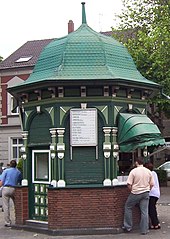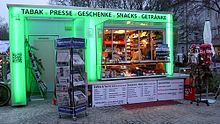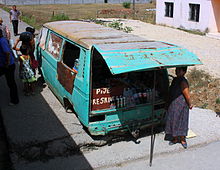Kiosk
![]()
The title of this article is ambiguous. For other meanings, see Kiosk (disambiguation).
A kiosk (borrowed before the 18th century from French kiosque, from Italian chiosco, from Spanish quiosco, from Ottoman كوشك Köšk "garden pavilion", from Persian کوشک Kūšk) is today in common usage the name for a small sales outlet in the form of a little house or a booth. Depending on the items sold, kiosks carry appropriate suffixes such as newspaper kiosk or flower kiosk. An example is the Trinkhalle.
Originally, a kiosk was a freestanding pavilion open on several sides in parks and palaces in the Islamic cultural area. In the technical language of architecture and landscape architecture, the term still has this meaning today.
The traditional ground plan was often polygonal or quadrangular with several arched openings. In function and form, there are more or less close affinities to a pavilion, a pergola, or an oriental tent. "Most of the buildings were single-storied and had only one room; other, somewhat larger structures were equipped with another story, several rooms, a portico, or arcades running all around."

Old newspaper kiosk at the Cornelius fountain in Düsseldorf

Kiosk of August Buxbaum at Kantplatz (Darmstadt)
Term History
The origin of the word kiosk lies in Middle Persian kūšk, which was adopted in the same form and meaning in New Persian (كوشك) and denotes a pavilion or a garden house. From there, the term entered Ottoman in the same spelling and modern Turkish as köşk. Both meanings remained in the Turkish language. At the beginning of the 18th century the word was transferred into French and became kiosque; from there it was adopted into other European languages and also into German.
In the 18th century, the word kiosk was known in Germany, but was only associated with Ottoman architecture. According to Johann Georg Krünitz, it was understood to mean "a building by the Turks, which consists of several not too high columns, which are set in such a way that they surround a [...] room, which is covered with a tent roof [...]. Such pleasure buildings or open halls are used by the Turks in their gardens and on hills to enjoy the fresh air and pleasant view." The term "pleasure buildings" refers to the activity of pleasure walking.
At the beginning of the 19th century, in German, a kiosk referred to garden pavilions "from which one enjoys the sight of a beautiful landscape [...] so that they afford some protection against the weather and the sun's rays and at the same time a friendly sight themselves. They usually consist of a few rough columns of tree trunks supporting a roof of thatch or wood, and are enclosed below with a simple railing."
After 1900, pavilions went out of fashion as vantage points and the term was applied to small stalls in cities.
In 1905, the Vossische Zeitung reported that the first newspaper kiosk had been set up in Berlin on Leipziger Platz.

Bundesbüdchen

Grüner Pavillon at the Altmarkt in Duisburg-Hamborn - oldest Duisburg kiosk from 1890
Cultural History
Kiosk-like buildings have existed since the 13th century in Persia, India and the Ottoman Empire. In Topkapı-Saray in Istanbul, some examples are preserved (Çinili kiosk of 1466, Revan and Baghdad kiosks of 1635, Kara Mustafa Pasha's kiosk of the 18th century and Abd ül-Mejid's kiosk of 1840). Oriental kiosks were important elements of garden architecture and served as summer homes for the wealthy in their private estates. With the end of the Ottoman Empire, interest in this form of courtly architecture was lost.
In connection with the preference for the Asian-Oriental style in the 18th century, the design - usually standing freely on columns and closed off at the sides with latticework - came to Europe as part of the landscaped parks that many rulers had built. They are mentioned for the first time in England.
There are also examples of kiosk buildings in the complexes of Stanislaus I, Duke of Lorraine and Bar in Lunéville, and of the French King Louis XV. Striking examples in Germany include the Chinese House in Potsdam, begun in 1755, as well as those built by Ludwig II of Bavaria at Linderhof Palace or in the Winter Garden of the Munich Residenz.
In the 19th century, the kiosk was introduced as a sales pavilion in the large public parks of Paris, later on the large boulevards. At first, only newspapers and flowers were sold here, later also refreshments. The neologism boulevard newspaper also originated here. Some of these famous Parisian kiosks still exist today. In Greece, the name of the kiosk (periptero) is derived from the temple building form peripteros.
In common usage, the kiosk has been equated in German since the 19th century with a small stall selling tobacco products, sweets, drinks, newspapers, etc. In the Ruhr area and the Rhineland, as well as in the Hanover area, such kiosks are also called Trinkhalle, in the Rhine-Main area Wasserhäuschen, elsewhere Bude or Büdchen. The oldest German kiosks offered drinks, only since the beginning of the 20th century also newspapers. Well known is the listed Magdeburger Sahneröschen. In the Hannover Region there are currently (2019) 385 kiosks, of which around 300 are in the city of Hannover, some of which are listed buildings.
The father of the kiosk trade in Switzerland was the bookseller Frédéric Zahn, who was inspired by the colporteurs and opened the first Swiss kiosk at Le Locle station in 1883. These offered the wares of the major daily newspapers for sale by hand. With the increasing importance of rail transport, the profession spread to French- and Italian-speaking Switzerland via France and Italy. Zahn embraced the movement by selling books and newspapers to commuters at Le Locle station with the aid of a table. In doing so, he laid the foundations for the largest kiosk operator in Europe, the Valora Group, with almost 2000 outlets in Germany, Switzerland, Austria and Luxembourg.
Although today kiosks often sell alcoholic beverages, the early kiosks were associated with the anti-alcohol movement. On the one hand, this applies to mineral water huts, which sold carbonated water from the 1840s onwards, and later also lemonades or ice cream. On the other hand, hundreds of milk houses have been built since the turn of the century, especially in the industrial region of Rhineland-Westphalia. The collapse of the milk supply in and after the First World War led to an expansion of the product ranges. Alcoholic beverages, however, only became common after the 2nd World War.
In the 1950s, the Waldner company built a total of 50 toadstool-shaped kiosks, which were originally intended to sell dairy products and were also exported. Some of the ones that still exist today are now listed as historic monuments.

24-hour kiosk in Munich

Kiosk in the shape of a toadstool in Regensburg (2019)

Newspaper kiosk on the Leipzig market (1961)

Kiosk on a railway platform in Albania
Questions and Answers
Q: What is a kiosk?
A: A kiosk is a small booth that offers goods and services.
Q: What kind of goods and services are usually offered in a kiosk?
A: Packaged food, drinks, cigarettes and newspapers are usually sold in a kiosk.
Q: Are kiosks still common in train stations?
A: Yes, kiosks can still be seen in some train stations.
Q: What is happening to the old kiosks in Paris?
A: The old kiosks in Paris that sold newspapers, cigarettes and tickets are being replaced.
Q: Why are the new kiosks in Paris said to be less charming?
A: The new kiosks in Paris are said to be less charming because they are more functional.
Q: How do kiosks differ in oriental countries like Persia and Turkey?
A: In oriental countries like Persia and Turkey, kiosks are larger and grander, and are self-standing buildings.
Q: What is the main difference between the kiosks in English speaking countries and in oriental countries?
A: The main difference between the kiosks in English speaking countries and in oriental countries is that kiosks in oriental countries are self-standing buildings that are larger and grander than those in other countries.
Search within the encyclopedia